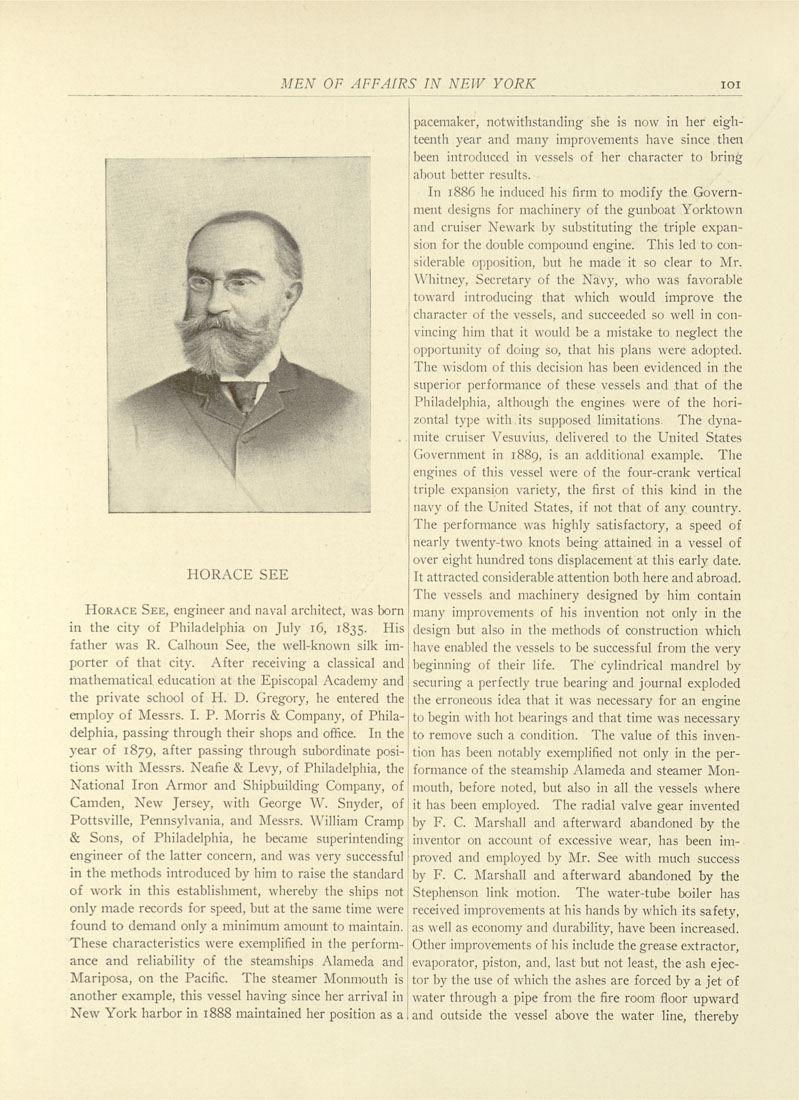MEN OF AFFAIRS IN NEW YORK
lOI
HORACE SEE
Horace See, engineer and naval architect, was born
in the city of Philadelphia on July i6, 1835. His
father was R. Calhoun See, the well-known silk im¬
porter of that city. After receiving a classical and
mathematical education at the Episcopal Academy and
the private school of H. D. Gregory, he entered the
employ of Messrs. I. P. Morris & Company, of Phila¬
delphia, passing through their shops and office. In the
year of 1879, after passing through subordinate posi¬
tions with Messrs. Neafie & Levy, of Philadelphia, the
National Iron Armor and Shipbuilding Company, of
Camden, New Jersey, with George W. Snyder, of
Pottsville, Pennsylvania, and Messrs. William Cramp
& Sons, of Philadelphia, he became superintending
engineer of the latter concern, and was very successful
in the methods introduced by him to raise the standard
of work in this establishment, whereby the ships not
only made records for speed, but at the same time were
found to demand only a minimum amount to maintain.
These characteristics w^ere exemplified in the perform¬
ance and reliability of the steamships Alameda and
Mariposa, on the Pacific. The steamer Monmouth is
another example, this vessel having since her arrival in
New York harbor in 1888 maintained her position as a
pacemaker, notwithstanding she is now in her eigh¬
teenth year and many improvements have since then
been introduced in vessels of her character to bring
about better results.
In 1886 he induced his firm to modify the Govern¬
ment designs for machinery of the gunboat Yorktown
and cruiser Newark by substituting the triple expan¬
sion for the double compound engine. This led to con¬
siderable opposition, but he made it so clear to Mr.
Whitney, Secretary of the Navy, who was favorable
toward introducing that which would improve the
character of the vessels, and succeeded so well in con¬
vincing him that it would be a mistake to neglect the
opportunity of doing so, that his plans were adopted.
The wisdom of this decision has been evidenced in the
superior performance of these vessels and that of the
Philadelphia, although the engines were of the hori¬
zontal type with its supposed limitations. The dyna¬
mite cruiser Vesuvius, delivered to the United States
Government in 1889, is an additional example. The
engines of this vessel were of the four-crank vertical
triple expansion variety, the first of this kind in the
navy of the United States, if not that of any country.
The performance was highly satisfactory, a speed of
nearly twenty-two knots being attained in a vessel of
over eight hundred tons displacement at this early date.
It attracted considerable attention both here and abroad.
The vessels and machinery designed by him contain
many improvements of his invention not only in the
design but also in the methods of construction which
have enabled the vessels to be successful from the very
beginning of their life. The cylindrical mandrel by
securing a perfectly true bearing and journal exploded
the erroneous idea that it was necessary for an engine
to begin with hot bearings and that time was necessary
to remove such a condition. The value of this inven¬
tion has been notably exemplified not only in the per¬
formance of the steamship Alameda and steamer Mon¬
mouth, before noted, but also in all the vessels where
it has been employed. The radial valve gear invented
by F. C. Marshall and afterward abandoned by the
inventor on account of excessive wear, has been im¬
proved and employed by Mr. See with much success
by F. C. Marshall and afterward abandoned by the
Stephenson link motion. The water-tube boiler has
received improvements at his hands by which its safety,
as well as economy and durability, have been increased.
Other improvements of his include the grease extractor,
evaporator, piston, and, last but not least, the ash ejec¬
tor by the use of which the ashes are forced by a Jet of
water through a pipe from the fire room floor upward
and outside the vessel above the water line, thereby
|








